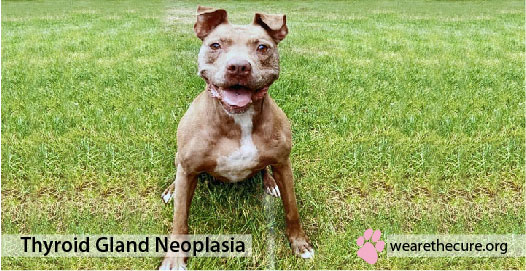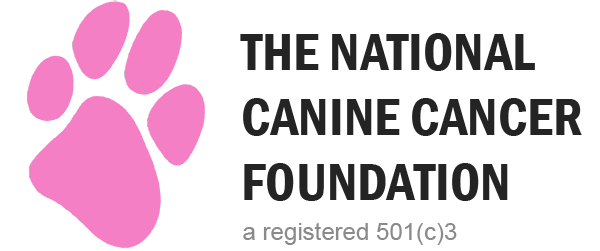
Thyroid Cancer in Dogs: Symptoms, Diagnosis, Treatment, and Prognosis
Thyroid gland neoplasia is a rare but serious form of cancer in dogs, accounting for just 1.2% to 3.8% of all canine tumors. Despite its rarity, thyroid cancer can be aggressive, often spreading (metastasizing) to other parts of the body.
This page will walk you through the signs to watch for, how it’s diagnosed, treatment options, and what to expect — all written for concerned dog parents in plain language.
What Is Thyroid Gland Neoplasia?
Thyroid gland neoplasia is a tumor arising from the thyroid gland, located in your dog’s neck. These tumors are often classified by how they appear under a microscope (follicular, compact, papillary, or anaplastic), with follicular and compact types being most common in dogs.
Thyroid tumors tend to affect older dogs, especially breeds like Boxers, Golden Retrievers, and Beagles, and can become invasive and spread rapidly if not caught early.
Symptoms of Thyroid Cancer in Dogs
The most common early sign is a firm, non-painful lump in your dog’s neck — usually discovered when petting or grooming.
Other symptoms may include:
- Coughing
- Rapid breathing or panting
- Trouble swallowing (dysphagia)
- Change in bark or voice (dysphonia)
- Swelling in the face (facial edema)
- Unexplained bleeding in the neck area
- Weight loss and muscle wasting
- Increased hunger, thirst, and urination (if the tumor is overactive — hyperthyroidism)
Important: These signs may be subtle at first. If you notice any lump in your dog’s neck or other unusual behavior, schedule a veterinary exam immediately.
What Causes Thyroid Cancer in Dogs?
The exact cause of thyroid cancer in dogs is not fully understood. However, researchers have identified some contributing factors:
- Excessive thyroid-stimulating hormone (TSH)
- Radiation exposure to the neck area
- Lack of thyroid hormone replacement in dogs with hypothyroidism
Most thyroid tumors in dogs are nonfunctional — meaning they do not secrete excessive thyroid hormones. Only a small percentage cause hyperthyroidism, which leads to symptoms like increased appetite, thirst, urination, and restlessness.
How Is It Diagnosed?
Diagnosis begins with a physical exam, followed by advanced imaging and lab tests. Your vet may recommend:
- Complete blood count (CBC) and blood chemistry panel
- Urinalysis
- Three-view chest X-rays (to check for spread to the lungs)
- Ultrasound of the neck (cervical ultrasonography)
- Fine needle aspiration or biopsy of the thyroid mass and nearby lymph nodes
Ultrasound is particularly helpful in assessing how aggressive the tumor is and whether it has invaded surrounding tissue.
However, due to the high blood supply to thyroid tumors, biopsies can be risky and sometimes inconclusive.
Treatment Options for Thyroid Tumors in Dogs
Treatment depends on several factors:
- Size and location of the tumor
- Whether it has spread (metastasized)
- Whether it is producing excess thyroid hormone
1. Surgical Removal (Thyroidectomy)
If the tumor is localized and not invading critical structures (like blood vessels or nerves), surgery is often the best option. Dogs who undergo successful thyroidectomy for non-metastatic tumors can live up to 3 years or more.
2. Radiation Therapy
For tumors that cannot be fully removed or have spread locally, external beam radiation can control tumor growth. Some dogs receive hypofractionated radiation (higher doses over fewer sessions) for comfort and tumor reduction.
3. Chemotherapy
Chemotherapy is used when the cancer has metastasized. Drugs like doxorubicin or cisplatin may help shrink tumors, especially when used with radiation.
Partial remission has been reported in 30–50% of dogs receiving chemo.
4. Can Targeted Therapies Help Dogs With Thyroid Cancer?
In some cases — especially when surgery or radiation isn’t an option — veterinarians may recommend a type of cancer treatment called a targeted therapy.
One such medication is toceranib phosphate (brand name Palladia), which is designed to interfere with the signals that cancer cells use to grow and spread. It belongs to a class of drugs called tyrosine kinase inhibitors (TKIs).
In certain studies, dogs with thyroid carcinoma who received targeted therapy showed tumor shrinkage or slower disease progression, with some living over 18–36 months, depending on how advanced the cancer was and how they responded to treatment.
Targeted therapies are typically managed by veterinary oncologists and may not be right for every dog. Side effects and monitoring are important considerations.
Prognosis: What to Expect
The outlook varies based on how early the cancer is caught and how far it has spread.
| Treatment Approach | Median Survival Time |
|---|---|
| Full surgical removal (no spread) | ~3 years |
| Incomplete surgery + radiation | 1–3 years |
| Radiation alone (non-resectable tumor) | 8–22 months |
| With gross metastasis + radiation | ~22 months |
| Chemo (doxorubicin/cisplatin) | Partial remission in 30–50% |
If the tumor has invaded nerves, blood vessels, or caused laryngeal paralysis, prognosis worsens due to complications like aspiration pneumonia or internal bleeding.
 Frequently Asked Questions
Frequently Asked Questions
What are the signs of thyroid cancer in dogs?
The most common sign is a firm lump in the neck. Dogs may also experience coughing, difficulty swallowing, hoarseness, weight loss, and increased hunger or thirst.
Can thyroid cancer in dogs be cured?
If caught early and surgically removed, dogs can live several years cancer-free. If the tumor has spread, treatment focuses on managing symptoms and improving quality of life.
Is thyroid cancer painful for dogs?
Most dogs do not show pain in early stages, but discomfort can occur if the tumor affects nerves or causes swelling or bleeding in the neck.
How common is thyroid cancer in dogs?
Thyroid tumors are relatively rare in dogs, accounting for about 1.2% to 3.8% of all canine tumors.
References
- Withrow & MacEwen’s Small Animal Clinical Oncology – Stephen J. Withrow, DVM, DACVIM (Oncology), Colorado State University
- David M. Vail, DVM, DACVIM (Oncology), University of Wisconsin-Madison
- Merck Veterinary Manual: Thyroid Tumors in Dogs
- Enache, A., Schoeman, J.P., et al. (2023). Diagnosis and management of canine thyroid carcinomas. Veterinary Practice. https://www.veterinary-practice.com/article/diagnosis-and-management-of-canine-thyroid-carcinomas
Thank you for utilizing our Canine Cancer Library. Please help us keep this ever evolving resource as current and informative as possible with a donation.
Other Articles of Interest:
Blog: How To Help Pay For Your Dog Cancer Treatment Cost: 7 Fundraising Ideas
Blog: What Are Good Tumor Margins in Dogs and Why Are They Important?
Blog: Dispelling the Myths and Misconceptions About Canine Cancer Treatment
Blog: Financial Support for Your Dog’s Fight to Beat Cancer
Blog: Cancer Does Not Necessarily Mean A Death Sentence
Blog: What To Do When Your Dog Is Facing A Cancer Diagnosis – Information Overload
Blog: Dog Cancer Warning Signs: Help! I Found a Lump on My Dog



Recent Comments